Pros
Cons
Introduction
Front
{{section_header}}{{section.name}}{{/section_header}}
The {{product.name}} is a French door refrigerator, meaning its refrigerator section has two doors, under which is a large pull-out freezer.
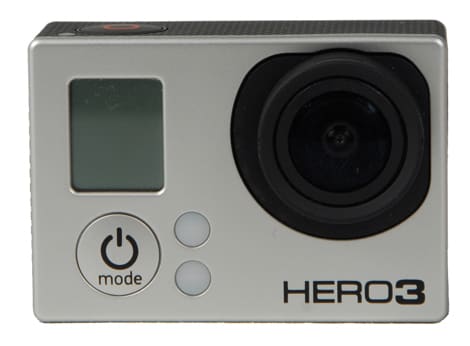
You'll definitely notice fingerprints on the refrigerator's stainless steel facade—and they're really hard to clean off.

The {{product.name}}'s handle has an ellipsoid shape that fits well in the hand. The handles don't pick up fingerprints as easily as the fridge itself.

The handles meet the fridge with a squared-off top. Note the mirrored sheen of the door compared to the matte finish of the handles: that's why you'll see every fingerprint on the fridge's doors, but won't see any on the handles.
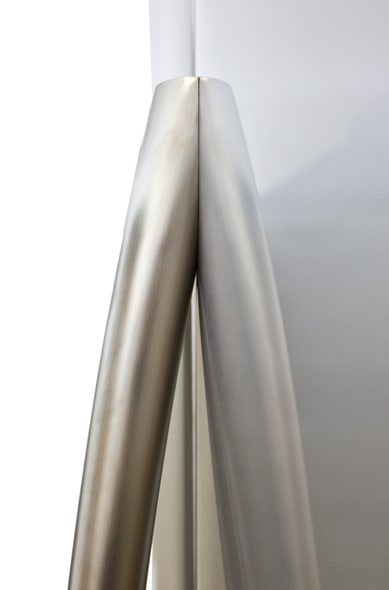
The water and ice dispenser is located on the left door and can be activated by pushing in on the curved handle.

The dispenser's controls don't just affect the output of ice or water: it serves as a control center for the fridge. If you want to quickly freeze or cool something, press and hold the Adjust Freezer or Adjust Refrigerator button for three seconds.
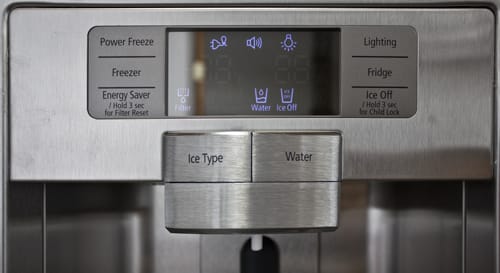
The ice comes down from the chute right above the handle.
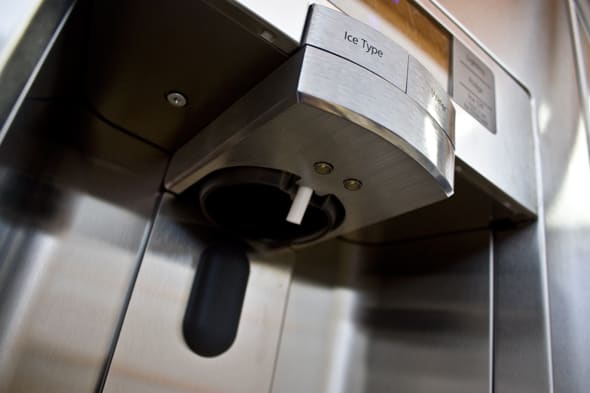
Interior
{{section_header}}{{section.name}}{{/section_header}}
The refrigerator gives you two doors and a large main space with myriad shelves and drawers.
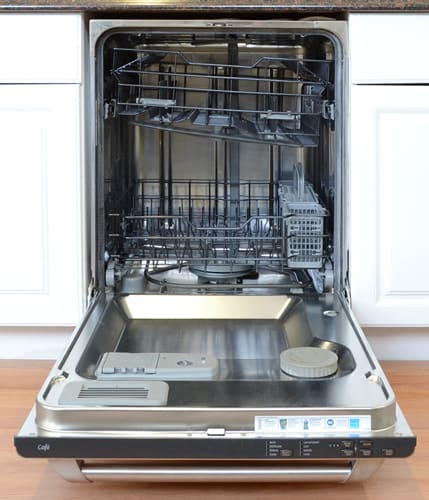
The interior of the CDWT980VSS.
The top half of the main refrigerator area has several removable shelves. While there isn't much vertical space in which to move the shelves around, the fridge lets you stack objects fairly deep. The left-most shelf on top can flip up to accommodate wine bottles or other tall objects. There's also a little bottle caddy suspended from the second set of shelves (it can be attached to any shelf).
At the bottom of the fridge are three drawers, two crispers with dials for humidity, and a long, flat, temperature-controlled drawer.
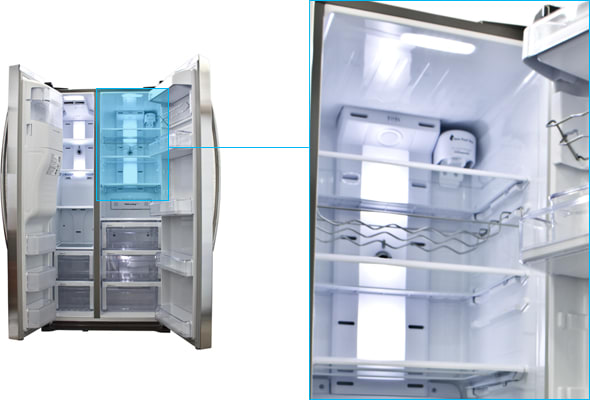
The water filter is located in the top right of the fridge.
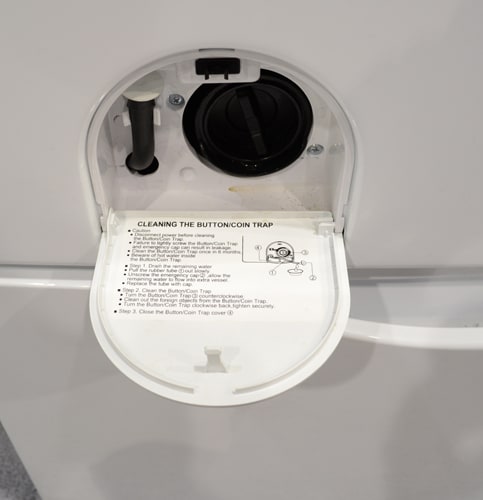
The left door doesn't have many storage options because the ice chute takes up a lot of space. In fact, the shelf directly above the ice chute is so narrow it's hard to find something small enough to store there.
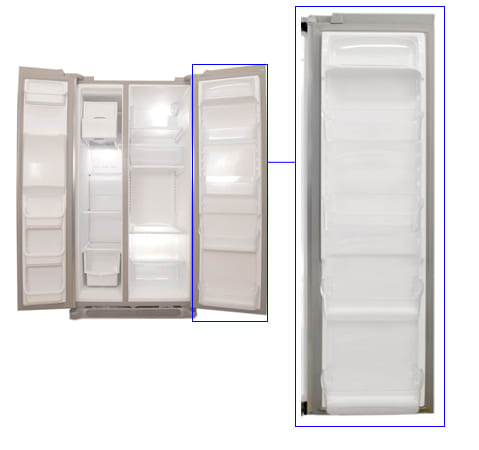
The right door has two shelves that can be removed and slotted elsewhere. There's also a large butter drawer.
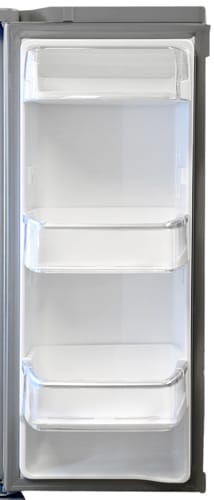
The door bins here are quite large, holding up to two gallons and four water bottles each.
The freezer is located under the refrigerator. The main basin has a movable divider.
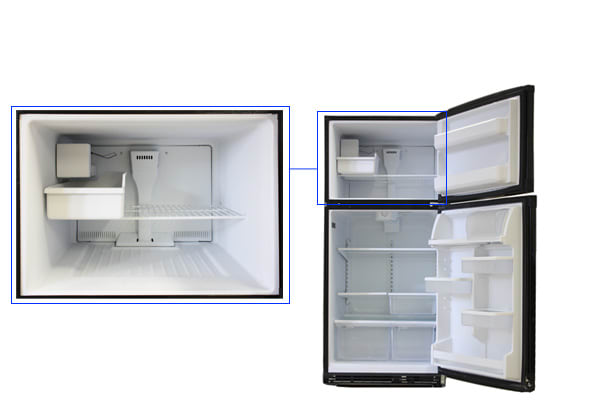
Above the main basin is a drawer that pulls out almost as far as the freezer itself.
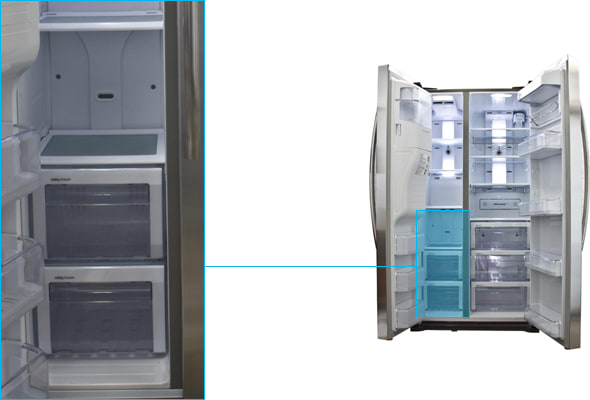
There's also a small shelf above the main basin. It offers some storage space, but it's not particularly deep.
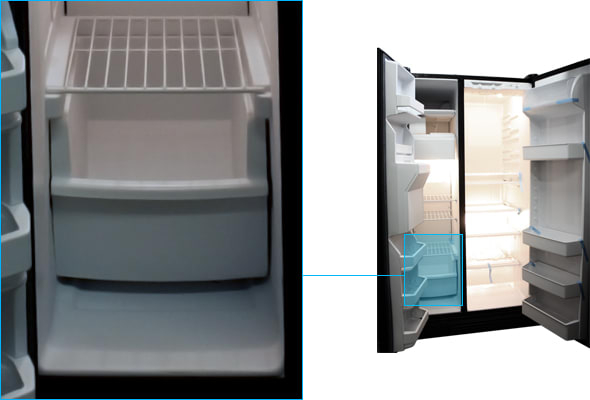
The shelf has a trap door on one side labeled Max 16" Pizza Door. If you find normal pizza doors just can't accommodate your pizza needs, the Max 16" Pizza Door provides the maximum space (16 inches) for your pizzas.
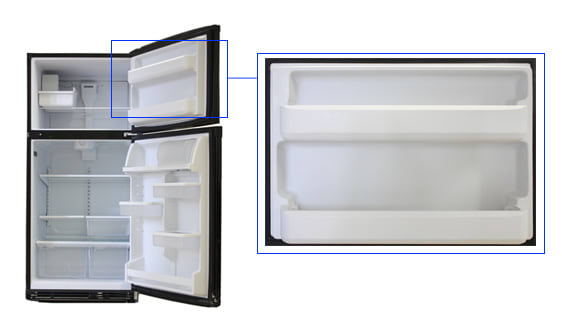
The ice-maker is actually not located in the freezer: it's in its own little enclosure in the top left corner of the fridge. It dispenses ice through the chute in the door.
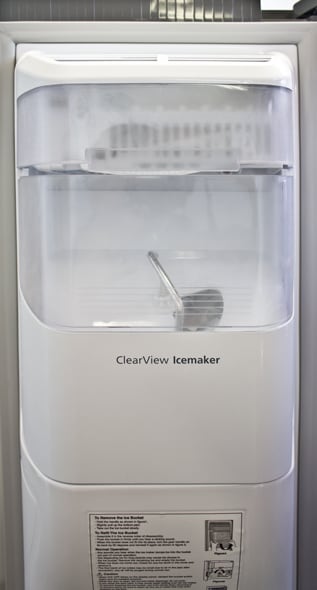
Back
{{section_header}}{{section.name}}{{/section_header}}
The back of the fridge has a water hookup and not much else.
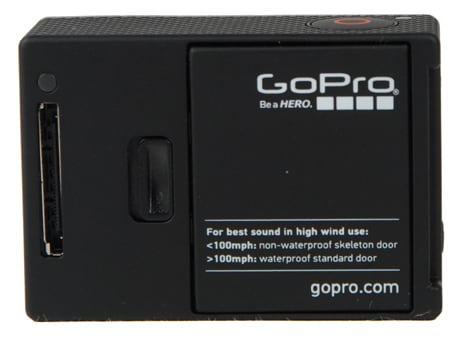
Sides
{{section_header}}{{section.name}}{{/section_header}}
The sides of the fridge aren't nearly as fancy as its facade: they're just gray plastic. This fridge was definitely meant to be hidden away.
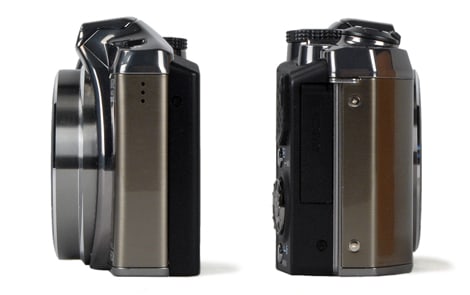
Olympus SZ-31MR iHS side views
Running Cost
{{section_header}}{{section.name}}{{/section_header}}
We calculated the running cost of this refrigerator at about $53.48 over the period of a year. That's about average for a refrigerator of this size and capacity.
Power Use Per Cu Ft
{{section_header}}{{section.name}}{{/section_header}}
We also calculate and score on the power use per cubic foot of space, which we calculated at 0.09 KW/h. Again, that's pretty much in line with other similar products we have looked at.
Fridge Temperature
{{section_header}}{{section.name}}{{/section_header}}
A refrigerator has to chill your food and keep it at a constant temperature. If that temperature varies too much, this can spoil the food, with too cold freezing the food and too hot allowing it to decay. So, we put fake food packages into the refrigerator at a number of locations, each of which is fitted with a temperature sensor.
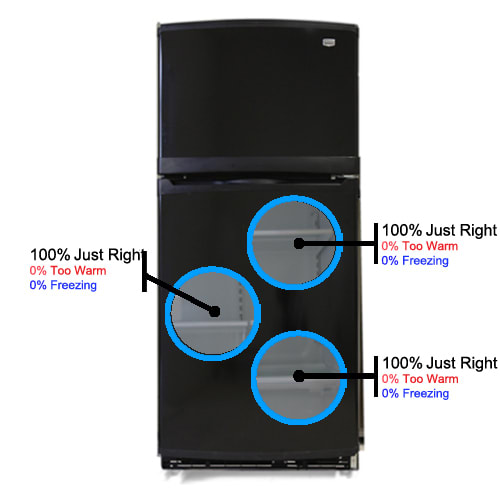
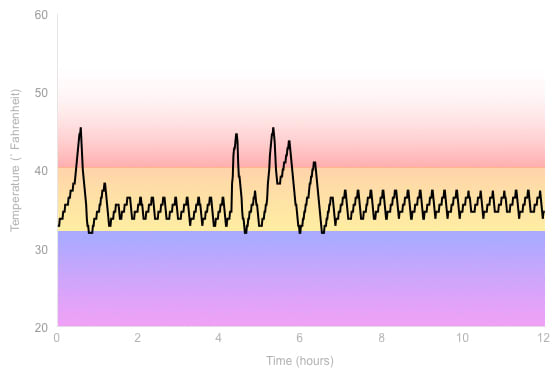
The graph above shows a typical 12 hours from our testing (the full test runs over several days), with the yellow zone on the graph representing the Goldilocks zone: not too hot, not too cold, but just right. As you can see, the temperature does dip in and out of the zone a little, both on the hot and cold sides. These variations are only very slight, though, and food should be well preserved in this refrigerator.
Freezer Temperature
{{section_header}}{{section.name}}{{/section_header}}
The freezer temperature is also pretty consistent, which will help preserve frozen food. The design of the freezer no doubt helps here: the freezer section is one big drawer which helps to capture the cold air and to stop it from escaping when you open it to take something out.
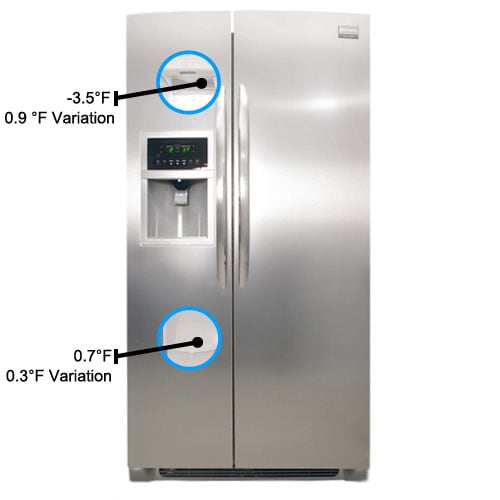
Vegetable Drawer
{{section_header}}{{section.name}}{{/section_header}}
The vegetable drawer of a refrigerator is designed to keep the veges cold, but without drying them out. To test this, we put in a fake vegetable made of floral foam soaked in water, and monitor the weight of this over a few days. The {{product.name}} was slightly disappointing in this test, with our test vegetable losing around 0.2 grams of water an hour. This means that your vegetables will dry our a little quicker than we like to see, so this tray won't keep your veggies fresh for more than a few days.
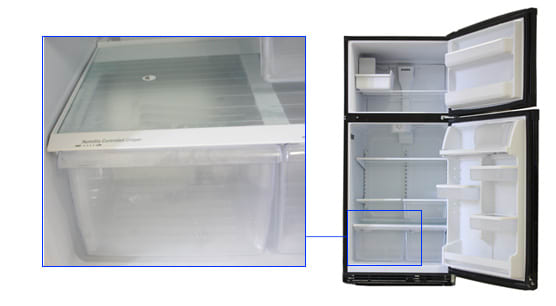
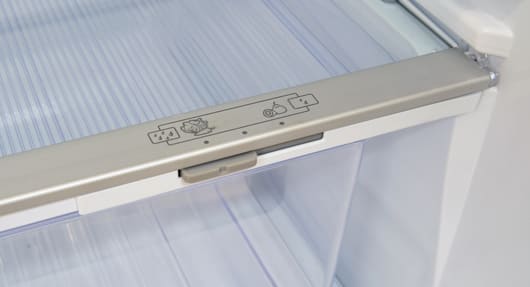
Power Loss
{{section_header}}{{section.name}}{{/section_header}}
When the lights go out, your refrigerator should still be able to keep your frozen food cold. We found that our fake food in this refrigerator was still frozen after 36 hours, although some smaller items may be defrosted after this length of time. But most power cuts are only for a few hours, so this refrigerator performed well in this test.
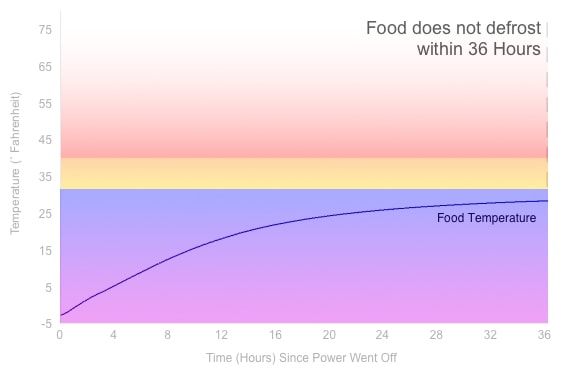
Freezing Performance
{{section_header}}{{section.name}}{{/section_header}}
Fast freezing is the key to preserving the texture of your frozen food. We test this by putting a block of our fake food fitted with a temperature sensor into the freezer, and them timing how long it takes to freeze. For this refrigerator, we found that this took 1 hour and 24 minutes, which is pretty fast.

Usable Space
{{section_header}}{{section.name}}{{/section_header}}
Manufacturers tend to be generous with refrigerator volume. They account for basically all of the space inside the fridge, regardless of how unfeasible it would be to perfectly fit all your groceries into a neat cube.
We weren't wowed by the {{product.name}} usable storage space, but it should be good enough for the most users: it had an average capacity. The main problem with the storage in the refrigerator is the inability to hang your shelves exactly where you want them. If you're having trouble squeezing in that turkey, your options are to cram it in there or move a shelf up eight inches and end up with wasted space.
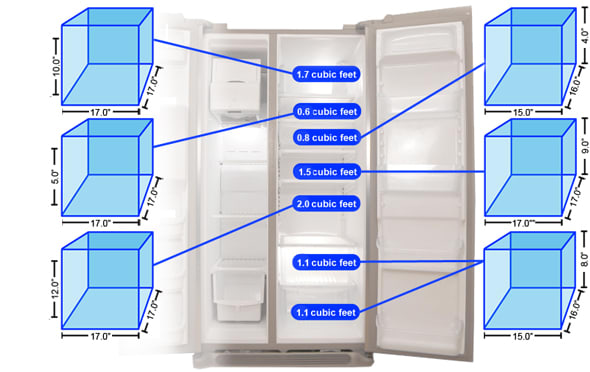
As a French door refrigerator, Again, this is an average refrigerator. You can fit a few gallon jugs of milk on the doors' shelves, which is convenient, and the butter drawer is fairly large. The best thing about the door, however, is it provides the customizability the main space lacks: you can nudge the shelves up or down a few inches at a time.
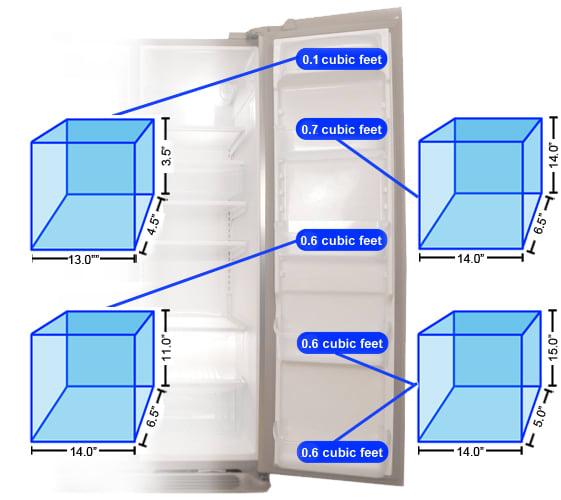
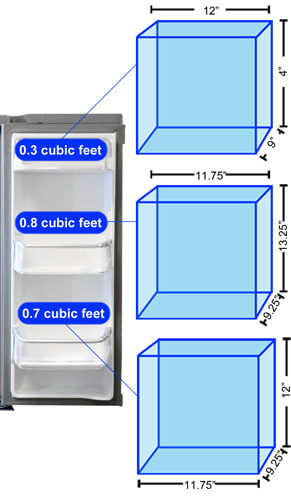
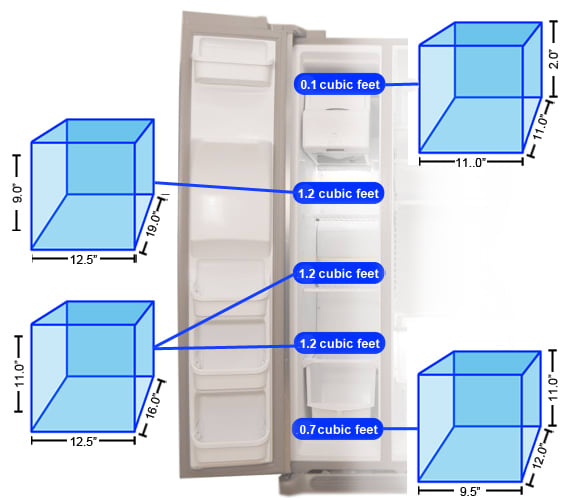
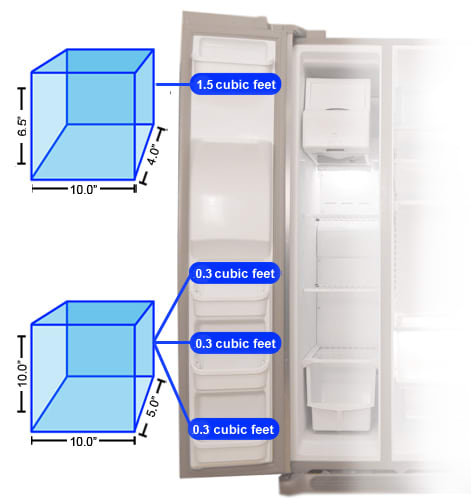
Below are the manufacturers own figures for capacity, and our own measurements for usable capacity. The manufacturers figures do not take account of the shelves, drawers and other removable features, but our measurements do account for the space these take up.
Ease of Access
{{section_header}}{{section.name}}{{/section_header}}
All of the features and spaces in the {{product.name}} are fairly easy to access. The water and ice dispenser at the door is placed at a good height to maximize usability. All of the drawers and shelves are removable and can be repositioned. The drawers slide open easily, even when they carry a lot of weight. Even the typically hard to reach areas, like the ice maker, are easy to access. You shouldn't have any accessibility issues with this fridge.
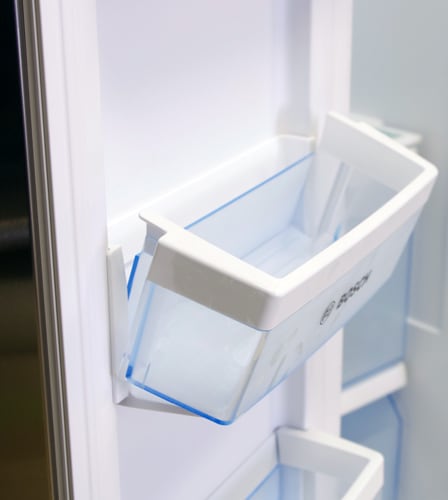
Controls
{{section_header}}{{section.name}}{{/section_header}}
This refrigerator has several sets of controls. The obvious controls are outside the fridge, on the water/ice dispenser, which let you control that feature and fiddle with temperature settings inside the fridge. The two crisper drawers inside have humidity controls, and the third drawer has humidity and temperature controls.

Water Dispenser
{{section_header}}{{section.name}}{{/section_header}}
The water dispenser outputs cool water (it is chilled in a reservoir inside the fridge), and it stays cold for a good long time. The flow rate is pretty high, filling up a glass in about 20 seconds.

Ice Maker
{{section_header}}{{section.name}}{{/section_header}}
The ice-maker is actually not located in the freezer: it's in its own little enclosure in the top left corner of the fridge. It dispenses ice through the chute in the door.

Cleaning
Noise
Other Features
{{section_header}}{{section.name}}{{/section_header}}
{{product.manufacturer_specs['Other Features Photo BROKEN?']}}
Specs
{{section_header}}{{section.name}}{{/section_header}}
The Samsung RG257 is a lot thinner (at 29.1 inches) than the {{product.name}} (at 35.5 inches), because the Samsung is a counter depth model that is designed to fit in with the standard width of a kitchen counter.
Design
{{section_header}}{{section.name}}{{/section_header}}
Both refrigerators have a similar design aesthetic, offering a stainless steel finish on the models that we looked at (both are also available in black finishes). Both also offer combination water and ice dispensers on the left side door. The two devices are quite different internally, though: the Samsung puts the refrigerator on the left side, while the GE has it at the bottom. This means that the freezer space of the GE is significantly wider, which can make it easier to pack and fill.
Performance
{{section_header}}{{section.name}}{{/section_header}}
Both devices had strong performance in our tests on refrigerator and freezer performance, producing fairly constant temperatures in both compartments. The GE had slightly better performance in the freezer compartment, though, presumably because the bottom freezer design exploits the tendency of cold air to fall, creating a pool of cold air that sits in the freezer compartment and cools the food.
{{score_bars comp_num="1", scores="Power Use Rating, Running Cost Rating, Fridge Temperature Rating, Power Loss Rating, Freezer Temperature Rating, Freezing Test Rating"}}
Storage Space
{{section_header}}{{section.name}}{{/section_header}}
The Samsung offers more storage space in total, with 11.48 cubic feet of usable fridge space and just under 5 feet of usable space in the freezer. The GE Profile offers 4.47 cubic feet of freezer space, but only 7.7 cubic feet of fridge space. However, the GE may be more suitable for those who like to store large items, as the bottom freezer design makes both the fridge and freezer space much wider than the Samsung. In the chart below, the first set of numbers are the manufacturers claimed capacity, while the second set of numbers are our own measurement of the usable space. The latter numbers are lower because the manufacturers numbers ignore the shelves and include the ice maker space, while ours count the shelves and do not count the ice maker.
{{score_bars comp_num="1", scores="Freezer Usable Space Rating, Fridge Usable Space Rating"}}
Usability
{{section_header}}{{section.name}}{{/section_header}}
Both refrigerators were easy to use, providing doors that open easily and trays that slide out easily even when loaded. The {{product.name}} has an ice holder that is a little easier to take out and empty if you want bulk ice, though: the Samsung has a smaller ice holder that is more difficult to remove and replace.
{{score_bars comp_num="1", scores="Usability Ease of Access Rating , Usability Controls Rating, Usability Water Rating, Usability Icemaker Rating, Usability Cleaning Rating"}}
Specs
{{section_header}}{{section.name}}{{/section_header}}
These two refrigerators have a different design approach: the Kenmore is a side-by-side refrigerator, while the {{product.name}} puts the freezer section at the bottom of the case. It is hard to say which approach is best: both have their good and bad points.
Design
{{section_header}}{{section.name}}{{/section_header}}
One good point of the GE Profile's design is the wider space it gives for storing frozen food. The tall and thin refrigerator of the Kenmore can be a bit constricting, while the big open space of the GE could hold a lot of food of various shapes and sizes.
Performance
{{section_header}}{{section.name}}{{/section_header}}
Both models performed well, producing consistent temperatures in both the refrigerator and freezer sections.
{{score_bars comp_num="2", scores="Power Use Rating, Running Cost Rating, Fridge Temperature Rating, Power Loss Rating, Freezer Temperature Rating, Freezing Test Rating"}}
Storage Space
{{section_header}}{{section.name}}{{/section_header}}
The Kenmore has more cubic footage, while the GE has space that is smaller, but is perhaps more usable.
{{score_bars comp_num="2", scores="Freezer Usable Space Rating, Fridge Usable Space Rating"}}
Usability
{{section_header}}{{section.name}}{{/section_header}}
Both refrigerators make it easy to both control the device and get at the food.
{{score_bars comp_num="2", scores="Usability Ease of Access Rating , Usability Controls Rating, Usability Water Rating, Usability Icemaker Rating, Usability Cleaning Rating"}}
Specs
{{section_header}}{{section.name}}{{/section_header}}
It is perhaps unfair to pitch a premium model like the {{product.name}} against a cheap model like the Frigidaire, but life is full of such unfair competitions. And it is no surprise that the GE generally comes out on top, as it is the more solidly built, better engineered device.
Design
{{section_header}}{{section.name}}{{/section_header}}
The GE has the cleaner, sharper design, but the Frigidaire has a very adequate design that is unlikely to sully your kitchen.
Performance
{{section_header}}{{section.name}}{{/section_header}}
The GE was the clear winner in our tests, producing more consistent fridge and freezer temperatures, which should mean that your food lasts longer. The GE also held up better when the power went out, with food remaining frozen after 36 hours, while the Whirlpool lost its cool after just over 30. If you live in an area with frequent power outages, it may be worth the extra for the GE.
{{score_bars comp_num="3", scores="Power Use Rating, Running Cost Rating, Fridge Temperature Rating, Power Loss Rating, Freezer Temperature Rating, Freezing Test Rating"}}
Storage Space
{{section_header}}{{section.name}}{{/section_header}}
The GE offers more space (especially in the fridge section), but the Whirlpool has enough space for most users.
{{score_bars comp_num="3", scores="Freezer Usable Space Rating, Fridge Usable Space Rating"}}
Usability
{{section_header}}{{section.name}}{{/section_header}}
We found both devices to be easy to use, but the GE is a little easier to control, and has a more sophisticated control system that makes it easier to set temperatures directly.
{{score_bars comp_num="3", scores="Usability Ease of Access Rating , Usability Controls Rating, Usability Water Rating, Usability Icemaker Rating, Usability Cleaning Rating"}}
Conclusion
Energy Efficiency
The {{product.name}} should cost about $54 a year to run, which is very acceptable for a device of this size.
Performance
Both the freezer and refrigerator temperatures were pretty constant, so food should keep well in this refrigerator. We also found that vegetables in either of the vegetable drawers did not loose much water, so they too should keep well. The ice maker is a little small, though, and does not keep as much ice on tap as some other devices.
Storage Space
The {{product.name}} offers a good amount of fridge space, with several shelves that can be removed or relocated as required. There are also three drawers (two vegetable and one fresh drawer) and plenty of space in the fridge door. This door can also hold larger items such as gallons of milk and large bottles, and there are two wire trays: one for cans, and one for bottles to keep a bottle of white wine nice and chilled. The refrigerator is a little more cramped, though, with the ice maker taking a lot of space in the door and the shelves not being overly wide. It should be big enough for most users, but big families and bulk buyers will quickly fill it up.
Usability
The {{product.name}} is an easy to use refrigerator, with easy opening doors and easy slide drawers.
Meet the tester

RefrigeratorInfo.com Staff
Editor
RefrigeratorInfo.com Staff is a valued contributor to the Reviewed.com family of sites.
Checking our work.
Our team is here to help you buy the best stuff and love what you own. Our writers, editors, and experts obsess over the products we cover to make sure you're confident and satisfied. Have a different opinion about something we recommend? Email us and we'll compare notes.
Shoot us an email